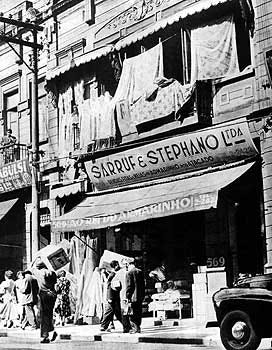Notable Sandwiches #12: Beirute
How Lebanon and Brazil came together in one sandwich
Welcome to the latest installment of Notable Sandwiches, the series in which I faithfully chronicle the bizarre and twisted document that is Wikipedia’s List of Notable Sandwiches, in alphabetical order.
Every time I write about a sandwich I’m reminded of how complex everything is, particularly those things that appear simple. The story of the beirute is no different.
It was war—internecine war, between Ottoman subjects—that first drove the Lebanese to Brazil. The Druze and the Maronite Christians were at war, and it was the Christians who fled, in droves; the Levantine silk trade was collapsing too, hunger bared its grim teeth, so they left. Approximately one-third of the Christians of Mount Lebanon emigrated between 1860 and 1914; according to one scholar of the Lebanese-Brazilian diaspora, Eliane Fersan, their proposed destination may not have been Brazil at all—just Amerka, the whole broad green new world in general, far from the snow and the cedars of Mount Lebanon. Having been turned away from the United States, or simply taken unwitting to a more southerly port, they came to the pampas and to the favelas, in their thousands and their hundreds of thousands.
It’s a widespread bit of folk wisdom, nearly impossible to verify, that there are more Lebanese in Brazil than the 4.7 million inhabitants of Lebanon itself. One reason this is difficult to trace is that Syrians and Lebanese people and Palestinians and all other immigrants from the Ottoman Empire were registered, undifferentiated, as turkos; by the time more precise tabulations were made, from the 1920s onward, the population had intermarried, and immigration had slowed. In the latter half of the nineteenth century, perhaps sensing the approaching end to slavery—Brazil, with its 4 million enslaved Africans, was a slaveholding stronghold until 1888, the longest of all the Americas—the nation’s leaders grasped for a larger, whiter population to work its lands. Between 1870 and 1930, three million immigrants came to Brazil.
Europeans—from Portugal and Italy and Germany and Spain—often came with agreements to work on farms, to gain land. Ottoman subjects had no such guarantees, and largely worked in trade, buying goods in São Paulo and selling them throughout the rural interior, even deep into the Amazon. It was grueling and dangerous work, but as the Lebanese-Brazilian writer Milton Hatoum put it in his novel Brothers, “You cannot get free with only words.” And the peddlers—mascates—became merchants, and sold kibbe and sfiha and hummus and halwa, and prospered.
The Sword and the Sandwich is a newsletter about serious extremism and equally serious sandwiches. Please consider supporting this work with a paid subscription:
It was greed that brought the cattle to Brazil—the insatiable greed of exploration and colonization; and like so many other violent reshapings of the world it started with Columbus. The eager taking and reluctant bestowal of species, animals, plants and diseases is often given the quaint name “the Columbian Interchange”—an innocuous term for something that killed civilizations. Still, Columbus and his successors brought sheep and goats and cattle and horses to the Caribbean. Five centuries later, cows in the Americas still carry the genetic imprint of their Iberian forebears. From there the animals were dispersed throughout the Americas, accompanying colonists; as native peoples were felled by disease and subjugated in grinding, attritive warfare, the cattle herds swelled and grew on sweet grass.
As the writer Maciej Ceglowski put it in his magnificent, funny essay Argentina on Two Steaks A Day,
“This most docile, placid, and passive of large herbivores stepped off the boat, took one nibble at the pampas and made a run for it. It knew that it wanted to spend the rest of its life eating the pampas grass, without outside interference. And the settlers, once they caught some of the early escapees, began to feel the same way about the beef.”
Though the pampas extend no further north than Brazil’s southernmost state, Rio Grande del Sul, the country is the world’s largest exporter of beef, and its second largest producer; though Brazil has a large population, 212 million, there are a million and a half more cows than people, grazing and dying for the world’s pleasure.
What brought them together, the Lebanese Brazilians and the grass-fed beef of the beirute, was bread, and bread is everywhere, and needs little by way of clumsy expository annotation. It’s as old as husbandry, and older. This is the second Brazilian beef sandwich I’ve written about (or around); what distinguishes the beirute in the cosmology of Brazilian beef sandwiches, and sets it apart from the bauru, the carne louca, the x-salada, is its bread: pão sírio, Levantine flatbread adorned with sumac and za’atar. Inside: mozzarella cheese, lettuce, roast beef, more za’atar, with its subtle, grassy hyssop taste.
The old world and the new: the tang of tomato that sprouted in the Americas and took root everywhere, the European aurochs tamed and dragged across the sea and bred and multiplied, the delicate watery leaf of the lettuce which was first cultivated in Ancient Egypt six thousand years ago, all nestled in a warm yeasty pocket from the cedar mountains of Lebanon. In the beirute: war and famine and colonization, immigration and generations of hard labor, long painful journeys in cramped boats, the endless and fertile cross-pollination of culture and cruelty and trade that has characterized the human world for so long and will until its end—all this in one sandwich. How can it not sate you? Take a bite and let the savor linger, like a cool wind off the broad sea that brings and takes so much, like the smell of a jewel-red sumac flower, like the endless soughing sound of wind in miles and miles of grass.







People of Brazil, same as People of Lebanon, are ISRAELITES from the Tribe of Asher.
Have you actually eaten every sandwich that you write about?